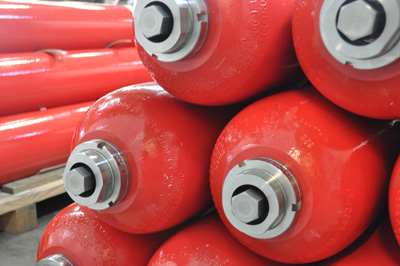Hydraulic accumulators are pressure vessels that store and discharge energy in the form of pressurized fluid. In essence, potential energy is stored in a compressed gas and released on demand to force oil from the accumulator and into the circuit. Here are some important benefits accumulators provide, and how they make hydraulic systems better.

Image courtesy of Accumulators Inc.
Energy storage. One of the most essential functions of accumulators is their ability to store energy. Particularly in cyclic or varying operations, the accumulator discharges in times of high demand and recharges during periods of low demand. One example is in plastic injection-molding machines, where high pressure and clamping force are only needed for a short segment of the entire manufacturing process.
Accumulators are often used to supplement pump flow during peak demand. Without an accumulator, the pump and motor must be sized to handle peak power requirements—even if maximum power is only required momentarily. With an accumulator, the system can be sized for average demand. This, in turn, permits a smaller pump that recharges the system during periods of slack demand. It also means a smaller motor, and a total system that demands less energy, generates less heat and costs less.
Emergency backup. Accumulators can maintain a high-pressure charge almost indefinitely and serve as an emergency power source should a machine lose electric power or a pump fails. Properly sized units can provide the necessary flow and pressure to retract a cylinder, close a valve, open a mold or move a machine to a safe position until power is restored or the malfunction is corrected.
Accumulators can also safeguard the lubricating film in critical bearings that must have a constant oil supply. If a lubricant pump fails, the accumulator maintains pressure until the machine stops or a secondary pump restores flow.
Vibration and shock reduction. Pumps, especially piston and gear types, generate pressure pulsations in hydraulic circuits. Sizable pressure spikes in hydraulic circuits are fairly common, too. Quick deceleration of large cylinders, impacts from excavator buckets, and sudden valve closure can generate pressure spikes. And hydraulic fluid readily transmits shocks and pulsations through hose and tubing, and that can play havoc with downstream components.
Mounting a small accumulator near the outlet of the pump can absorb pulsations, minimize vibration and provide smoother operation. Adding an accumulator into the return line of machines can mitigate shocks and cushion the effects to “water” hammer to prevent damage to the sensitive components. Curtailing system shocks will extend component life, reduce leaks from connectors and joints, and lower maintenance costs.
An accumulator also reduces overall hydraulic-system noise levels and the transmission of fluid-borne noise to adjacent mechanical structures that can, in turn, resonate. The result is quieter machines and happier operators.
Leakage compensation. Some hydraulic systems must maintain pressure and force when there is no motion or flow, such as holding a loaded cylinder in an extended position or a keeping a clamp closed for extended periods. In such cases, users often shut down the system to save energy. An accumulator can maintain constant pressure even if fluid slowly leaks internally past piston seals or valve clearances. Only when circuit pressure drops below preset limits does the pump fire up and recharge the accumulator.
Temperature compensation. Swings in ambient temperature or machine operating conditions can cause hydraulic-fluid temperature to fluctuate, and that affects overall system pressure. An accumulator can compensate for temperature-related pressure differences in a closed hydraulic system. Accumulators minimize the effect of pressure changes by adding or reducing the amount of fluid in a circuit.
Faster response. Bladder and diaphragm accumulators have virtually instantaneous response and can quickly supply fluid to fast-acting servo and proportional valves and improve their performance. Accumulators can also immediately meet peak flow requirements; help keep pressure constant in systems using variable-displacement pumps; and provide force compensation in continuous processes, such as rolling materials that offer varying working resistances, which ensures consistent output and improves productivity and quality.
Filed Under: Mobile Hydraulic Tips, Slider